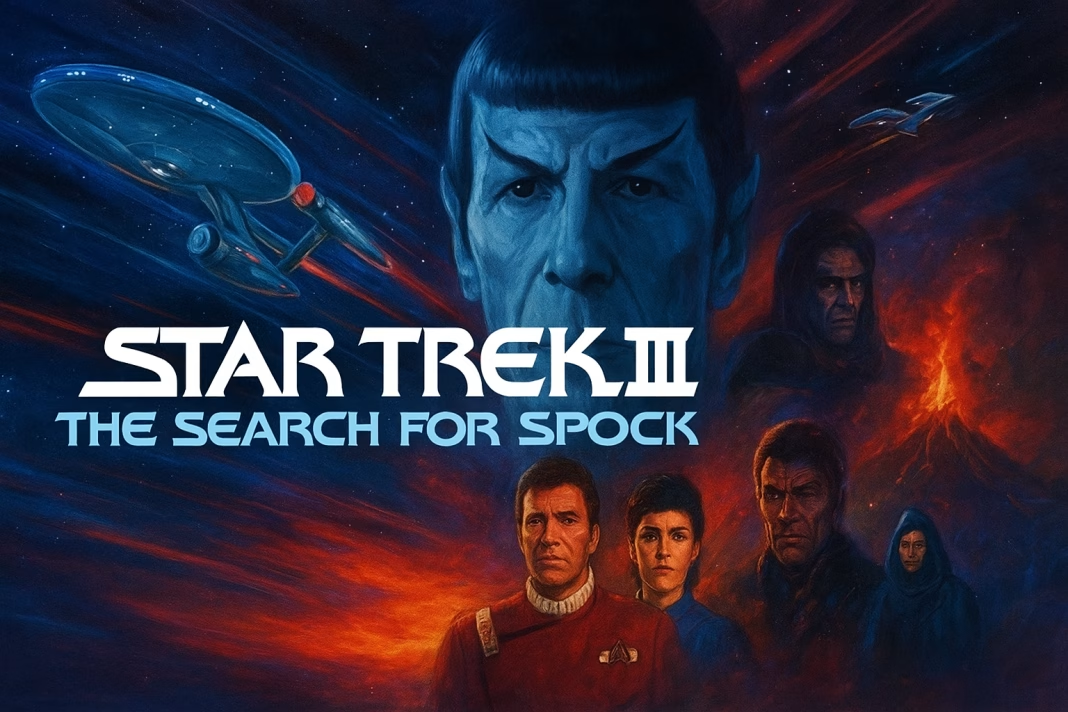Few sequels arrive burdened with expectations quite like Star Trek III: The Search for Spock. Its predecessor, The Wrath of Khan, concluded with one of the most emotional farewells in science fiction cinema – the death of Spock. For audiences in 1982, that moment felt final, almost sacred. Yet within two years, Paramount Pictures, under the guidance of Leonard Nimoy, decided to take the bold step of undoing that loss. The stakes were enormous: bring Spock back in a way that respected the audience’s emotions, maintained narrative integrity, and furthered the franchise’s momentum.
The result is a film that feels less like an independent adventure and more like an essential bridge between grief and reunion. Under Nimoy’s capable direction, supported by James Horner’s soaring musical score, The Search for Spock delivers moments of genuine emotional weight and thematic resonance, even if it sometimes feels structurally constrained by its purpose.
Reversing the Themes of Wrath of Khan
Harve Bennett’s screenplay smartly plays as an inversion of The Wrath of Khan. In that film, Spock gave his life to save the USS Enterprise, embodying the Vulcan maxim “the needs of the many outweigh the needs of the few.” In The Search for Spock, the equation is flipped: the Enterprise herself is sacrificed to save Spock. This thematic reversal underscores the crew’s deep loyalty and affection for their fallen friend.
The Genesis Planet – created from the detonation of the Genesis Device in Khan – serves as both a plot driver and a metaphor. Born from Spock’s coffin, the unstable planet becomes a symbol of nature’s unpredictability when tampered with. The accelerated aging process and environmental chaos there are stark reminders that even the noblest scientific pursuits can have unforeseen consequences.
The film’s climax, a solemn Vulcan ritual called fal-tor-pan, prioritizes the “needs of the one” over the collective good – a direct challenge to Spock’s own sacrifice. This bold narrative choice reframes the philosophical discussions from the previous film, making Search for Spock not just a continuation, but a deliberate thematic counterpoint.
Why Star Trek II: The Wrath of Khan Redefined Sci-Fi Cinema
A Grittier Vision of the 23rd Century
One of the film’s most distinctive contributions to Star Trek lore is its depiction of life beyond the pristine halls of Starfleet. Here, Earth and its broader Federation are given a sense of moral complexity rarely seen before. A smoky bar scene in San Francisco, populated by dubious characters, evokes shades of Star Wars’ Mos Eisley Cantina.
More striking is the revelation that Federation citizens are not all paragons of virtue. The secrets of the Genesis Project aren’t stolen through espionage but purchased from corrupt insiders. This detail quietly challenges the idea of the Federation as a flawless utopia, revealing it instead as a society with its own share of greed and moral compromise.
Nimoy’s Confident Directorial Debut
For his first time behind the camera, Leonard Nimoy delivers a focused and briskly paced story. At just 105 minutes, the film avoids the drawn-out pacing of some earlier Star Trek entries. The plot may dip into melodrama, but it’s tightly connected to the emotional fallout from Khan. The concept of Spock’s katra – his living essence – residing in Dr. McCoy adds a unique layer of urgency and humor to the mission.
One of the standout sequences is the daring theft of the decommissioned Enterprise. It’s a moment of pure cinematic joy, balancing tension, humor, and exhilaration. Horner’s score swells here, elevating the sequence into one of the franchise’s most memorable set pieces.
Performances and Character Arcs
The film’s emotional success rests heavily on its cast. William Shatner’s Kirk is a man navigating determination, grief, and personal loss. His reaction to the death of his son David is one of Shatner’s most raw and restrained moments as Kirk. DeForest Kelley shines as McCoy, managing to inject humor into his frustration while also delivering vulnerability in moments of possession by Spock’s katra.
Mark Lenard’s return as Sarek adds gravitas, while Dame Judith Anderson lends an otherworldly authority to the role of the Vulcan High Priestess. On the other hand, Robin Curtis’s debut as Saavik struggles to match the layered emotional delivery of Kirstie Alley’s portrayal in Khan.
Christopher Lloyd’s Klingon commander Kruge is a capable and imposing villain, but his motivations lack the intimate personal stakes that made Khan such a memorable adversary. This absence slightly flattens the dramatic tension, making him feel like a conventional antagonist rather than a truly iconic one.
The Emotional Core and Lasting Impact
The death of David Marcus, though secondary in plot terms, leaves a lasting emotional mark. For Kirk, it’s a devastating personal cost – a reminder that heroism comes with profound sacrifice. Knowledge of actor Merritt Butrick’s untimely death in real life adds another layer of poignancy when revisiting the film today.
James Horner’s score deserves special praise. His music not only heightens the action but deepens the emotional impact of key scenes, from the Enterprise’s theft to the final moment of Spock’s rebirth. In many ways, his work here surpasses even his celebrated compositions for The Wrath of Khan.
Final Thoughts
Star Trek III: The Search for Spock may never reach the operatic heights of The Wrath of Khan, but it was never meant to. Its role was to heal the narrative wound left by Spock’s death while moving the franchise toward its next chapter. In that respect, it succeeds admirably. Nimoy’s direction, the cast’s heartfelt performances, and Horner’s exceptional score combine to create a film that, while occasionally uneven, remains essential viewing for Star Trek fans.
Rating: 7/10 (+++) – An emotionally satisfying bridge between loss and renewal, anchored by memorable moments and a deep respect for its characters.
